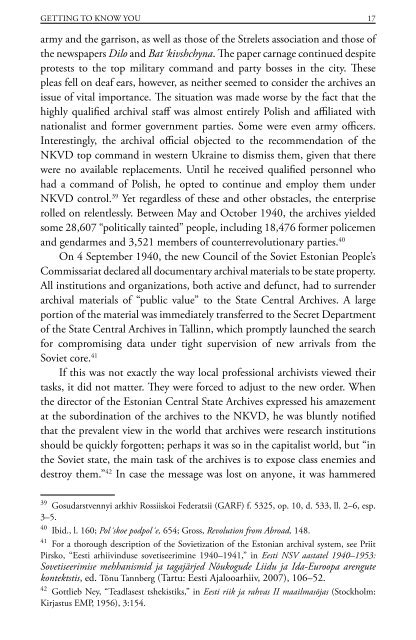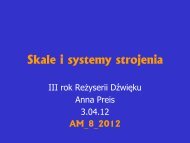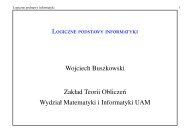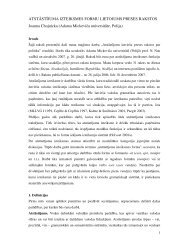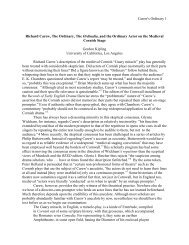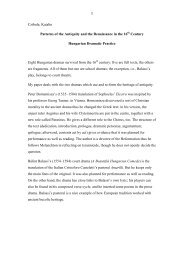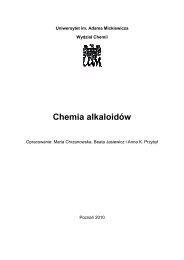Amir Weiner Getting to Know You
Amir Weiner Getting to Know You
Amir Weiner Getting to Know You
Create successful ePaper yourself
Turn your PDF publications into a flip-book with our unique Google optimized e-Paper software.
GETTING TO KNOW YOU 17<br />
army and the garrison, as well as those of the Strelets association and those of<br />
the newspapers Dilo and Bat´kivshchyna. The paper carnage continued despite<br />
protests <strong>to</strong> the <strong>to</strong>p military command and party bosses in the city. These<br />
pleas fell on deaf ears, however, as neither seemed <strong>to</strong> consider the archives an<br />
issue of vital importance. The situation was made worse by the fact that the<br />
highly qualified archival staff was almost entirely Polish and affiliated with<br />
nationalist and former government parties. Some were even army officers.<br />
Interestingly, the archival official objected <strong>to</strong> the recommendation of the<br />
NKVD <strong>to</strong>p command in western Ukraine <strong>to</strong> dismiss them, given that there<br />
were no available replacements. Until he received qualified personnel who<br />
had a command of Polish, he opted <strong>to</strong> continue and employ them under<br />
NKVD control. 39 Yet regardless of these and other obstacles, the enterprise<br />
rolled on relentlessly. Between May and Oc<strong>to</strong>ber 1940, the archives yielded<br />
some 28,607 “politically tainted” people, including 18,476 former policemen<br />
and gendarmes and 3,521 members of counterrevolutionary parties. 40<br />
On 4 September 1940, the new Council of the Soviet Es<strong>to</strong>nian People’s<br />
Commissariat declared all documentary archival materials <strong>to</strong> be state property.<br />
All institutions and organizations, both active and defunct, had <strong>to</strong> surrender<br />
archival materials of “public value” <strong>to</strong> the State Central Archives. A large<br />
portion of the material was immediately transferred <strong>to</strong> the Secret Department<br />
of the State Central Archives in Tallinn, which promptly launched the search<br />
for compromising data under tight supervision of new arrivals from the<br />
Soviet core. 41<br />
If this was not exactly the way local professional archivists viewed their<br />
tasks, it did not matter. They were forced <strong>to</strong> adjust <strong>to</strong> the new order. When<br />
the direc<strong>to</strong>r of the Es<strong>to</strong>nian Central State Archives expressed his amazement<br />
at the subordination of the archives <strong>to</strong> the NKVD, he was bluntly notified<br />
that the prevalent view in the world that archives were research institutions<br />
should be quickly forgotten; perhaps it was so in the capitalist world, but “in<br />
the Soviet state, the main task of the archives is <strong>to</strong> expose class enemies and<br />
destroy them.” 42 In case the message was lost on anyone, it was hammered<br />
39 Gosudarstvennyi arkhiv Rossiiskoi Federatsii (GARF) f. 5325, op. 10, d. 533, ll. 2–6, esp.<br />
3–5.<br />
40 Ibid., l. 160; Pol´skoe podpol´e, 654; Gross, Revolution from Abroad, 148.<br />
41 For a thorough description of the Sovietization of the Es<strong>to</strong>nian archival system, see Priit<br />
Pirsko, “Eesti arhiivinduse sovetiseerimine 1940–1941,” in Eesti NSV aastatel 1940–1953:<br />
Sovetiseerimise mehhanismid ja tagajärjed Nõukogude Liidu ja Ida-Euroopa arengute<br />
kontektstis, ed. Tõnu Tannberg (Tartu: Eesti Ajalooarhiiv, 2007), 106–52.<br />
42 Gottlieb Ney, “Teadlasest tshekistiks,” in Eesti riik ja rahvas II maailmasõjas (S<strong>to</strong>ckholm:<br />
Kirjastus EMP, 1956), 3:154.


